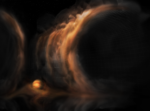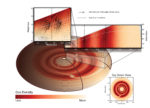ALMA Witness Planet Formation in Action
For the first time, astronomers using the Atacama Large Millimeter/submillimeter Array (ALMA) have witnessed 3D motions of gas in a planet-forming disk. At three locations in the disk around a young star called HD 163296, gas is flowing like a waterfall into gaps that are most likely caused by planets in formation. These gas flows have long been predicted and would directly influence the chemical composition of planets atmospheres. This research appears in the latest issue of the journal Nature.
The birthplaces of planets are disks made out of gas and dust. Astronomers study these so-called protoplanetary disks to understand the processes of planet formation. Beautiful images of disks made with ALMA show distinct gaps and ring features in the dust, which may be caused by infant planets.
To get more certainty that planets cause these gaps, and to get a complete view of planetary formation, scientists study the gas in the disks in addition to dust. Ninety-nine percent of a protoplanetary disk’s mass is gas, of which carbon monoxide (CO) is the brightest component, and ALMA can observe it.
Last year, two teams of astronomers demonstrated a new planet-hunting technique using this gas. They measured the velocity of CO gas rotating in the disk around the young star HD 163296. Localized disturbances in the movements of the gas revealed three planet-like patterns in the disk.
In this new study, lead author Richard Teague from the University of Michigan and his team used new high-resolution ALMA data from the Disk Substructures at High Angular Resolution Project (DSHARP) to study the gas’s velocity in more detail. “With the high-fidelity data from this program, we were able to measure the gas’s velocity in three directions instead of just one,” said Teague. “For the first time, we measured the motion of the gas in every possible direction. Rotating around, moving towards or away from the star, and up or downwards in the disk.”
Teague and his colleagues saw the gas moving from the upper layers towards the middle of the disk at three different locations. “What most likely happens is that a planet in orbit around the star pushes the gas and dust aside, opening a gap,” Teague explained. “The gas above the gap then collapses into it like a waterfall, causing a rotational flow of gas in the disk.”
This is the best evidence to date that there are indeed planets forming around HD 163296. But astronomers cannot say with one hundred percent certainty that planets cause the gas flows. For example, the star’s magnetic field could also cause disturbances in the gas. “Right now, only direct observation of the planets could rule out the other options. But, the patterns of these gas flows are unique, and very likely, only planets can cause them,” said coauthor Jaehan Bae of the Carnegie Institution for Science, who tested this theory with a computer simulation of the disk.
The location of the three predicted planets in this study correspond to the results from last year. Their positions probably are at 87, 140, and 237 AU (An astronomical unit – AU – is the average distance from the Earth to the Sun). The closest planet to HD 163296 is calculated to be half the mass of Jupiter, the middle planet is Jupiter-mass, and the farthest planet is twice as massive as Jupiter.
Gas flows from the surface towards the midplane of the protoplanetary disk have been predicted since the late nineties. But this is the first time that astronomers observed them. Besides being useful to detect infant planets, these flows can also shape our understanding of how gas giant planets obtain their atmospheres.
“Planets form in the middle layer of the disk, the so-called midplane. This is a cold place, shielded from radiation from the star,” Teague explained. “We think that the gaps caused by planets bring in warmer gas from the more chemically active outer layers of the disk and that this gas will form the atmosphere of the planet.”
Teague and his team did not expect that they would be able to see this phenomenon. “The disk around HD 163296 is the brightest and biggest disk we can see with ALMA,” said Teague. “But it was a big surprise to see these gas flows so clearly. The disks appear to be much more dynamic than we thought.”
“This gives us a much more complete picture of planet formation than we ever dreamed,” said coauthor Ted Bergin of the University of Michigan. “By characterizing these flows, we can determine how planets like Jupiter are born and characterize their chemical composition at birth. We might be able to use this to trace the birth location of these planets, as they can move during formation.”
Additional information
This research is presented in a paper titled: “Meridional flows in the disk around a young star,” by R. Teague et al. in Nature (doi: 10.1038/s41586-019-1642-0)
The Atacama Large Millimeter/submillimeter Array (ALMA), an international astronomy facility, is a partnership of the European Organisation for Astronomical Research in the Southern Hemisphere (ESO), the U.S. National Science Foundation (NSF) and the National Institutes of Natural Sciences (NINS) of Japan in cooperation with the Republic of Chile. ALMA is funded by ESO on behalf of its Member States, by NSF in cooperation with the National Research Council of Canada (NRC) and the Ministry of Science and Technology (MOST) in Taiwan and by NINS in cooperation with the Academia Sinica (AS) in Taiwan and the Korea Astronomy and Space Science Institute (KASI).
ALMA construction and operations are led by ESO on behalf of its Member States; by the National Radio Astronomy Observatory (NRAO), managed by Associated Universities, Inc. (AUI), on behalf of North America; and by the National Astronomical Observatory of Japan (NAOJ) on behalf of East Asia. The Joint ALMA Observatory (JAO) provides the unified leadership and management of the construction, commissioning and operation of ALMA.
Images
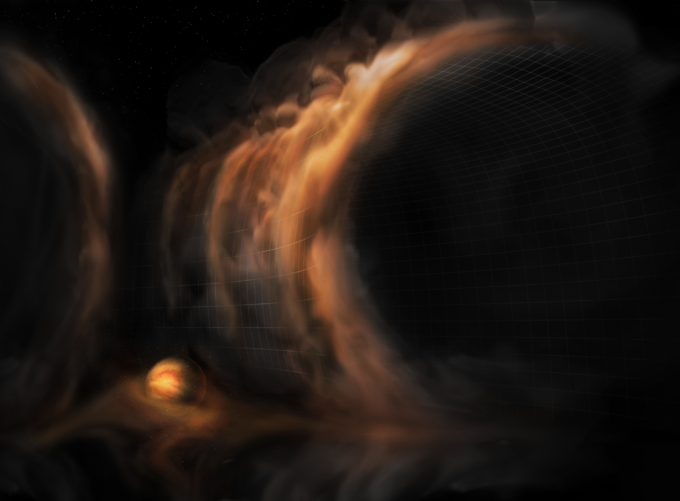
Artist’s impression of gas flowing like a waterfall into a protoplanetary disk gap, which is most likely caused by an infant planet. Credit: NRAO/AUI/NSF, S. Dagnello.
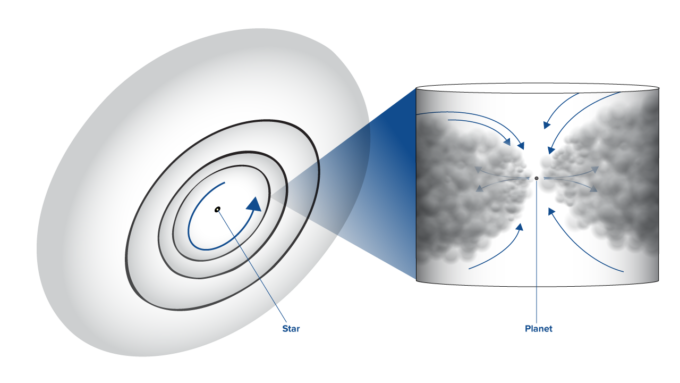
Scientists measured the motion of gas (arrows) in a protoplanetary disk in three directions: rotating around the star, towards or away from the star, and up- or downwards in the disk. The inset shows a close-up of where a planet in orbit around the star pushes the gas and dust aside, opening a gap. Credit: NRAO/AUI/NSF, B. Saxton.
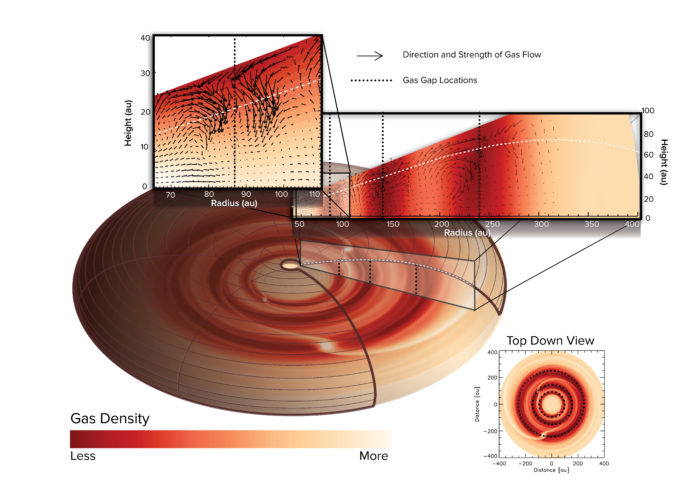
A computer simulation showed that the patterns of gas flows are unique and are most likely caused by planets in three locations in the disk. Planets in orbit around the star push the gas and dust aside, opening gaps. The gas above the gaps collapses into it like a waterfall, causing a rotational flow of gas in the disk. Credit: ALMA (ESO/NAOJ/NRAO), J. Bae; NRAO/AUI/NSF, S. Dagnello.
Animation
This animation shows the computer simulation of how the gas flows in the disk as a result of three planets in formation. Credit: ALMA (ESO/NAOJ/NRAO), J. Bae; NRAO/AUI/NSF, S. Dagnello.
Contacts
-
Nicolás Lira
Education and Public Outreach CoordinatorJoint ALMA Observatory, Santiago - ChilePhone: +56 2 2467 6519Cel: +56 9 9445 7726Email: [email protected] -
Iris Nijman
News and Public Information ManagerNational Radio Astronomy Observatory Charlottesville, Virginia - USACel: +1 (434) 249 3423Email: [email protected] -
Bárbara Ferreira
ESO Media Manager -
Masaaki Hiramatsu
Education and Public Outreach Officer, NAOJ Chile

